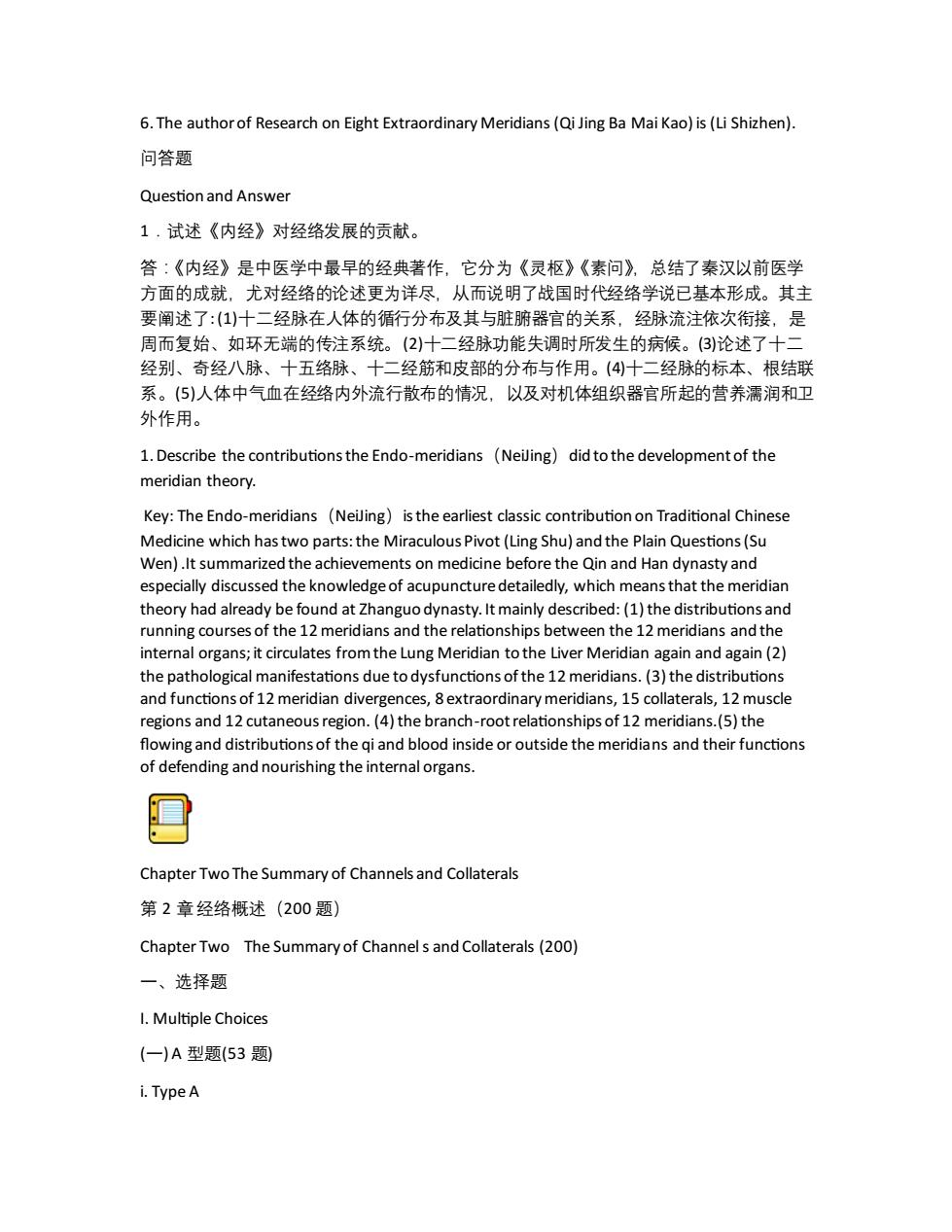正在加载图片...

6.The author of Research on Eight Extraordinary Meridians(Qi Jing Ba Mai Kao)is(Li Shizhen). 问答题 Question and Answer 1.试述《内经》对经络发展的贡献。 答:《内经》是中医学中最早的经典著作,它分为《灵枢》《素问》,总结了秦汉以前医学 方面的成就,尤对经络的论述更为详尽,从而说明了战国时代经络学说已基本形成。其主 要阐述了:(1)十二经脉在人体的循行分布及其与脏腑器官的关系,经脉流注依次衔接,是 周而复始、如环无端的传注系统。(2)十二经脉功能失调时所发生的病候。(3)论述了十二 经别、奇经八脉、十五络脉、十二经筋和皮部的分布与作用。(4)十二经脉的标本、根结联 系。(5)人体中气血在经络内外流行散布的情况,以及对机体组织器官所起的营养濡润和卫 外作用。 1.Describe the contributions the Endo-meridians (NeiJing)did to the development of the meridian theory. Key:The Endo-meridians (NeiJing)is the earliest classic contribution on Traditional Chinese Medicine which has two parts:the Miraculous Pivot(Ling Shu)and the Plain Questions(Su Wen).It summarized the achievements on medicine before the Qin and Han dynasty and especially discussed the knowledge of acupuncture detailedly,which means that the meridian theory had already be found at Zhanguo dynasty.It mainly described:(1)the distributions and running courses of the 12 meridians and the relationships between the 12 meridians and the internal organs;it circulates from the Lung Meridian to the Liver Meridian again and again(2) the pathological manifestations due to dysfunctions of the 12 meridians.(3)the distributions and functions of 12 meridian divergences,8 extraordinary meridians,15 collaterals,12 muscle regions and 12 cutaneous region.(4)the branch-root relationships of 12 meridians.(5)the flowing and distributions of the qi and blood inside or outside the meridians and their functions of defending and nourishing the internal organs. Chapter Two The Summary of Channels and Collaterals 第2章经络概述(200题) Chapter Two The Summary of Channel s and Collaterals(200) 一、选择题 1.Multiple Choices (一)A型题(53题) i.Type A6. The author of Research on Eight Extraordinary Meridians (Qi Jing Ba Mai Kao) is (Li Shizhen). 问答题 Question and Answer 1.试述《内经》对经络发展的贡献。 答:《内经》是中医学中最早的经典著作,它分为《灵枢》《素问》,总结了秦汉以前医学 方面的成就,尤对经络的论述更为详尽,从而说明了战国时代经络学说已基本形成。其主 要阐述了: (1)十二经脉在人体的循行分布及其与脏腑器官的关系,经脉流注依次衔接,是 周而复始、如环无端的传注系统。(2)十二经脉功能失调时所发生的病候。(3)论述了十二 经别、奇经八脉、十五络脉、十二经筋和皮部的分布与作用。(4)十二经脉的标本、根结联 系。(5)人体中气血在经络内外流行散布的情况,以及对机体组织器官所起的营养濡润和卫 外作用。 1. Describe the contributions the Endo-meridians(NeiJing)did to the development of the meridian theory. Key: The Endo-meridians(NeiJing)is the earliest classic contribution on Traditional Chinese Medicine which has two parts: the Miraculous Pivot (Ling Shu) and the Plain Questions (Su Wen) .It summarized the achievements on medicine before the Qin and Han dynasty and especially discussed the knowledge of acupuncture detailedly, which means that the meridian theory had already be found at Zhanguo dynasty. It mainly described: (1) the distributions and running courses of the 12 meridians and the relationships between the 12 meridians and the internal organs; it circulates from the Lung Meridian to the Liver Meridian again and again (2) the pathological manifestations due to dysfunctions of the 12 meridians. (3) the distributions and functions of 12 meridian divergences, 8 extraordinary meridians, 15 collaterals, 12 muscle regions and 12 cutaneous region. (4) the branch-root relationships of 12 meridians.(5) the flowing and distributions of the qi and blood inside or outside the meridians and their functions of defending and nourishing the internal organs. Chapter Two The Summary of Channels and Collaterals 第 2 章经络概述(200 题) Chapter Two The Summary of Channel s and Collaterals (200) 一、选择题 I. Multiple Choices (一) A 型题(53 题) i. Type A